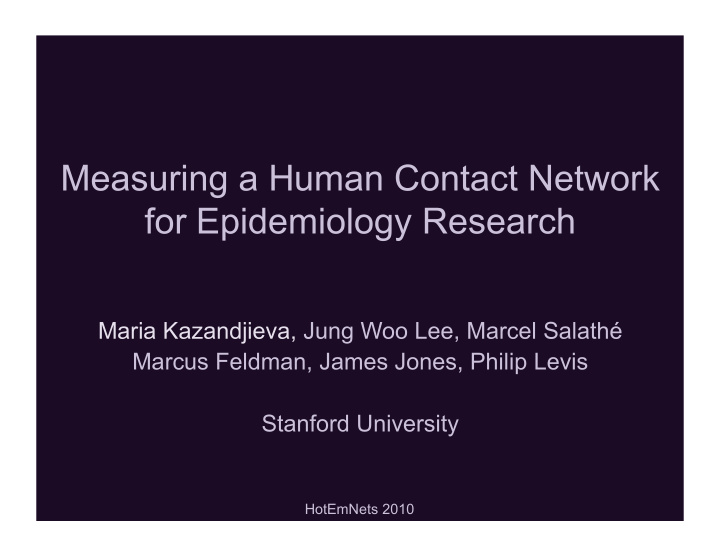



Measuring a Human Contact Network for Epidemiology Research Maria Kazandjieva, Jung Woo Lee, Marcel Salathé Marcus Feldman, James Jones, Philip Levis Stanford University HotEmNets 2010
Contact Networks Specify physical proximity interactions over time Used by National Institute of Health Center for Disease Control Key in determining how to limit disease spread e.g. vaccinations 2
Epidemiology’s Problem Not enough data! Pen-and-paper and survey methods are inaccurate have limited coverage 3
The Alternative Use technology to get more fine grained and accurate data Previous work has used cell phones and RFID on small populations 4
The Deployment 8-hour day at a U.S. high school - closed network environment 850 participants - students, teachers, staff 5+ school buildings 170 location nodes 5
the motes 6
The Code Over 1000 motes broadcasting periodic beacons Mote type Number Beacon interval TX Power participant 850 20 sec -16.9 dBm location 170 20 sec -11 dBm 7
Data Format source bcn_seqno rssi local_seqno 8
Preparation Program 1000+ motes Place 170 location motes the night before Prepare batches of 10 to 15 motes for teachers to distribute to students Brief the school 9
D-Day In at 6:30 am, out by 9 pm Distribute motes, pouches, and assent forms Participants write down the time and start the mote by inserting the second battery 4 pm - motes start to come back 10
11
12
The Rest of This Talk Pre-deployment considerations working with epidemiologists working with human subjects Post-deployment woes node resets and disconnections 13
Epidemiology Considerations Trade-off between time resolution of data and coverage 20 seconds is good enough 14
Human Subject Considerations Opting in and out user button vs. batteries Indicate state of the mote red vs. yellow LED 15
The Deployment 8-hour day at a U.S. high school 850 participants 5+ school buildings 16
D-Day Outcome 792 traces from participants Total of 3 million contact entries 17
But During the Deployment … Batteries fell out Batteries were taken out Students played with the reset button Motes were accidentally bumped against desks Students banged motes against hard surfaces Students swung motes by the lanyards Motes were rubbed together … to see what happens 18
Node reboots 272 nodes with uninterrupted data traces a.k.a. ‘safe motes’ 520 nodes with a total of over 1500 reboots 19
Hardware Resets source bcn_seqno rssi local_seqno 450 300 220 370 789 414 223 370 450 301 221 371 450 302 220 0 20
Extended Disconnection 40 60 80 local 120 200 0 60 safe node 330 150 180 21
Extended Disconnection, case 2 0 200 40 60 local 200 0 60 8 am safe node 30 330 300 22
Global Time No time synchronization code on the motes Only need relative time to place all subject interactions in context Tactic: choose a popular mote! 23
Global Time, p2 Everyone likes food… 93.6% of participants received a beacon from one mote in the dining area it became the global reference clock 24
Global Time mote 101 example source bcn_seqno local_seqno global 1700 450 10 0 ….. ….. 10055 1750 50 1750 25
Global Time, result A lookup table Node ID Global time at start 101 1700 102 1800 … … 145 ??? 26
You did all this work, so what? 27
28
Takeaways Sensor networks provide an opportunity improve the understanding of disease spread. Large-scale deployments can benefit from standard tools for mass programming. 29
Discussion 30
Recommend
More recommend